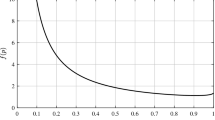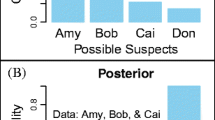Abstract
Let F, G be a pair of absolutely continuous cumulative distributions, where F is the distribution of interest and G is assumed to be known. The composition \(G^{-1}\circ F\), which is referred to as the generalised hazard function of F with respect to G, provides a flexible framework for statistical inference of F under shape restrictions, determined by G, which enables the generalisation of some well-known models, such as the increasing hazard rate family. This paper is concerned with the problem of testing the null hypothesis \({\mathscr {H}}_0\): “\(G^{-1}\circ F\) is convex”. The test statistic is based on the distance between the empirical distribution function and a corresponding isotonic estimator, which is denoted as the greatest relatively-convex minorant of the empirical distribution with respect to G. Under \({\mathscr {H}}_0\), this estimator converges uniformly to F, giving rise to a rather simple and general procedure for deriving families of consistent tests, without any support restriction. As an application, a goodness-of-fit test for the increasing hazard rate family is provided.




Similar content being viewed by others
Change history
20 April 2022
A Correction to this paper has been published: https://doi.org/10.1007/s00362-022-01311-1
Notes
Evaluated over the whole support.
The computational work has been performed in Mathematica (Wolfram Research 2019).
Scale and location parameters are not considered, because they do not affect the test statistic. As usual, \(\varPhi \) denotes the standard normal distribution.
References
Barlow RE, Proschan F (1969) A note on tests for monotone failure rate based on incomplete data. Ann Math Stat 40(2):595–600
Barlow RE, Van Zwet WR (1969) Asymptotic properties of isotonic estimators for the generalized failure rate function. part 1: Strong consistency. Tech. rep., California Univ Berkeley operations research center
Barlow RE, Marshall AW, Proschan F (1963) Properties of probability distributions with monotone hazard rate. Ann Math Stat 34(2):375–389
Barlow R, Bartholomew D, Bremner J, Brunk H (1971) Statistical inference under order restrictions. Wiley, Hoboken
Bickel P (1969) Tests for monotone failure rate II. Ann Math Stat 40(4):1250–1260
Bickel PJ, Doksum KA (1969) Tests for monotone failure rate based on normalized spacings. Ann Math Stat 40(4):1216–1235
Chen Y, Samworth RJ (2013) Smoothed log-concave maximum likelihood estimation with applications. Stat Sinica 23:1373–1398
Deshpande JV (1983) A class of tests for exponentiality against increasing failure rate average alternatives. Biometrika 70(2):514–518
Dümbgen L, Rufibach K et al (2009) Maximum likelihood estimation of a log-concave density and its distribution function: basic properties and uniform consistency. Bernoulli 15(1):40–68
Durot C (2008) Testing convexity or concavity of a cumulated hazard rate. IEEE Trans Reliab 57(3):465–473
El Barmi H, Malla G, Mukerjee H (2021) Estimation of a distribution function with increasing failure rate average. J Stat Plann Inference 213:179–192
Gijbels I, Heckman N (2004) Nonparametric testing for a monotone hazard function via normalized spacings. J Nonparametr Stat 16(3–4):463–477
Grenander U (1956) On the theory of mortality measurement: part ii. Scand Actuar J 1956(2):125–153
Groeneboom P (2020) Grenander functionals and Cauchy’s formula. Scand J Stat. https://doi.org/10.1111/sjos.12449
Groeneboom P, Jongbloed G (2012) Isotonic \({L}_2\)-projection test for local monotonicity of a hazard. J Stat Plann Inference 142(7):1644–1658
Groeneboom P, Jongbloed G (2013) Testing monotonicity of a hazard: asymptotic distribution theory. Bernoulli 19(5A):1965–1999
Groeneboom P, Jongbloed G (2014) Nonparametric estimation under shape constraints, vol 38. Cambridge University Press, Cambridge
Groeneboom P, Jongbloed G (2018) Some developments in the theory of shape constrained inference. Stat Sci 33(4):473–492
Hall P, Van Keilegom I (2005) Testing for monotone increasing hazard rate. Ann Stat 33(3):1109–1137
Hall P, Huang LS, Gifford JA (2001) Nonparametric estimation of hazard rate under the constraint of monotonicity. J Comput Graph Stat 10(3):592–614
Khan RA, Bhattacharyya D, Mitra M (2021) Exact and asymptotic tests of exponentiality against nonmonotonic mean time to failure type alternatives. In: Statistical Papers, pp 1–31
Kiefer J, Wolfowitz J (1977) Asymptotically minimax estimation of concave and convex distribution functions. ii. In: Statistical Decision Theory and Related Topics, Elsevier, pp 193–211
Kirmani S, Gupta RC (2001) On the proportional odds model in survival analysis. Ann Inst Stat Math 53(2):203–216
Lando T (2021) A test for the increasing log-odds rate family. Stat Probab Lett 170:109017
Lando T, Arab I, Oliveira PE (2020) Properties of increasing odds rate distributions with a statistical application. preprint
Majumder P, Mitra M (2019) Detecting trend change in hazard functions-an L-statistic approach. Stat Pap 62:31–52
Marshall AW, Proschan F (1965) Maximum likelihood estimation for distributions with monotone failure rate. Ann Math Stat 36(1):69–77
Marshall AW, Olkin I (2007) Life distributions, vol 13. Springer, Berlin
Nadarajah S (2009) Bathtub-shaped failure rate functions. Qual Quant 43(5):855–863. https://doi.org/10.1007/s11135-007-9152-9
Nelson WB (2003) Applied life data analysis, vol 521. Wiley, Hoboken
Proschan F, Pyke R (1967) Tests for monotone failure rate. Fifth Berkley Symp 3:293–313
Robertson T, Wright FT, Dykstra RL (1988) Order restricted statistical inference. Wiley, Hoboken
Sahoo S, Sengupta D (2017) Testing the hypothesis of increasing hazard ratio in two samples. Comput Stat Data Anal 114:119–129
Samworth RJ (2018) Recent progress in log-concave density estimation. Stat Sci 33(4):493–509
Sengupta D, Paul D (2005) Some tests for log-concavity of life distributions. Preprint available at http://anson.ucdavis.edu/~debashis/techrep/logconca.pdf
Sweet AL (1990) On the hazard rate of the lognormal distribution. IEEE Trans Reliab 39(3):325–328
Tenga R, Santner TJ (1984) Testing goodness of fit to the increasing failure rate family. Naval Res Logist Q 31(4):617–630
Van Zwet WR (1964) Convex transformations of random variables. MC Tracts
Wang Y, Hossain AM, Zimmer WJ (2005) Tables of bounds for distributions with monotone log-odds rate. Commun Stat Simul Comput 34(1):1–20
Wolfram Research I (2019) Mathematica, Version 12.0. Champaign, IL
Funding
This research was supported by the Italian funds ex MURST 60% 2020. I acknowledge the support of the Czech Science Foundation (GACR) under Project 20-16764S and VŠB-TU Ostrava under the SGS Project SP2021/15.
Author information
Authors and Affiliations
Corresponding author
Ethics declarations
Conflict of interest
The author declares that he has no conflict of interest.
Additional information
Publisher's Note
Springer Nature remains neutral with regard to jurisdictional claims in published maps and institutional affiliations.
Rights and permissions
About this article
Cite this article
Lando, T. Testing convexity of the generalised hazard function. Stat Papers 63, 1271–1289 (2022). https://doi.org/10.1007/s00362-021-01273-w
Received:
Revised:
Accepted:
Published:
Issue Date:
DOI: https://doi.org/10.1007/s00362-021-01273-w




